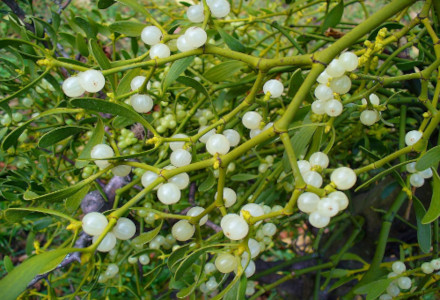
Mistletoe Facts
- In general cultural usage, people apply the short term of Mistletoe to any of the related plants placed in the, perhaps humorously-named, Order of Santalales. Originally, however, the term was used to refer to the single specific species presented herein.
- It’s formal, scientific name’s relatively easy to pronounce, as such things go. That’s because it bears the technical name of the Viscum album. It has several common names, though. These include the terms of European mistletoe and common mistletoe.
- It further shares a distinction with many other species around the world. That’s due to the fact that the Swedish botanist and zoologist, Carl Linnaeus, made the first formal acknowledgement of it, officially recognizing it as a separate and distinct species.
- It’s featured prominently in cultural uses in many parts of the world, including Europe and North America. Though not native to the latter region of the world, it’s present in cultivation. In those regions where not found, related native species replace its usage.
- Fortunately, all known varieties of Mistletoe appear to be maintaining population bases that are both stable and sufficient. The IUCN therefore either lists them all as Least Concern, or has no current listing for them. That could potentially change, however.
- Like most species, it does face some threats to its continued existence. Habitat loss naturally poses a threat to the wild populations, of course. Yet its greatest source of danger most likely consists of the ever-growing perils presented by climate change.
Related Articles
Mistletoe Physical Description
As a variety of Mistletoe, the amazing Viscum album evolved as a special type of evergreen shrub. That’s because it’s actually what botanists classify as a hemi-parasitical plant. This evolutionary path lead it to form different physical traits than many other flora.
In many ways, its general form resembles vines. This marvel of Nature and evolution produces numerous thin, elongated stems. Even among mature specimens, however, these display vastly different measurements, due to local environmental conditions.
The majority of individuals, though, produce copious stems that attain lengths averaging from 12 – 39 in (30 – 100 cm). Each of these further branch out multiple times. These also frequently tend to wind around each other, often producing a somewhat rounded shape.
Its leaves, meanwhile, typically appear in opposite pairs. They also usually display highly smooth, rounded edges, with a distinctive smooth leathery texture. This foliage additionally averages 0.8 – 3.15 in (2 – 8 cm) in length, and about 0.3 – 1 in (0.8 – 2.5 cm) in width.
That part of this particular form of the awesome Mistletoe generally presents a yellowish-green color. The flowers remain quite small, averaging no more than 0.12 in (3 mm) when open. The fruit also appears as a tiny, rounded berry, most often yellow or white in color.
- Kingdom: Plantae
- Phylum: Angiosperm
- Class: Eudicots
- Order: Santalales
- Family: Santalaceae
- Genus: Viscum
- Species: V. album
Mistletoe Distribution, Habitat, and Ecology
Fortunately, both for the beautiful Mistletoe itself, and for those of us who appreciate Nature, this particular variety inhabits a relatively broad swathe of the globe. That’s due to the fact that it evolved as endemic to certain portions of Africa, Europe and Asia.
It lives in most of Europe, beginning in Scandinavia, and moving southward. This also includes the isle of Great Britain. In Africa, meanwhile, it appears in parts of the northern section. But in Asia, the plant mainly lives in the eastern section, including Japan.
This incredible product of untold ages of evolution holds yet another advantage over many species. That’s because it evolved as highly general in its choice of habitat. More precisely, the resourceful plant appears wherever any of several varieties of trees appear.
It makes its home almost exclusively on several types of broad-leaf trees. These primarily consist of polar, hawthorn, lime, and apple trees, of various varieties. Though it does appear on other species occasionally, such divergence from the norm remains extremely rare.
From its home on its choice of host tree, this specific variety of Mistletoe, like its relatives, draws most of its nourishment directly from the host. These include water and nutrients taken via root-like structures. Those, however, extend under the bark of the tree.
It’s long been extremely popular in Western folklore, in connection with the Christmas Season. Surprisingly, this holds true despite the fact that this variety, the Viscum album, is highly toxic! Ingestion in concentration can even prove fatal in some instances.
Species Sharing Its Range
Check out our other articles on 4 Wondrous Asian Waterfalls, Swell Shark, Lake Hillier, California red-sided garter snake, Black-and-white hawk-eagle, Texas Blind Salamander

